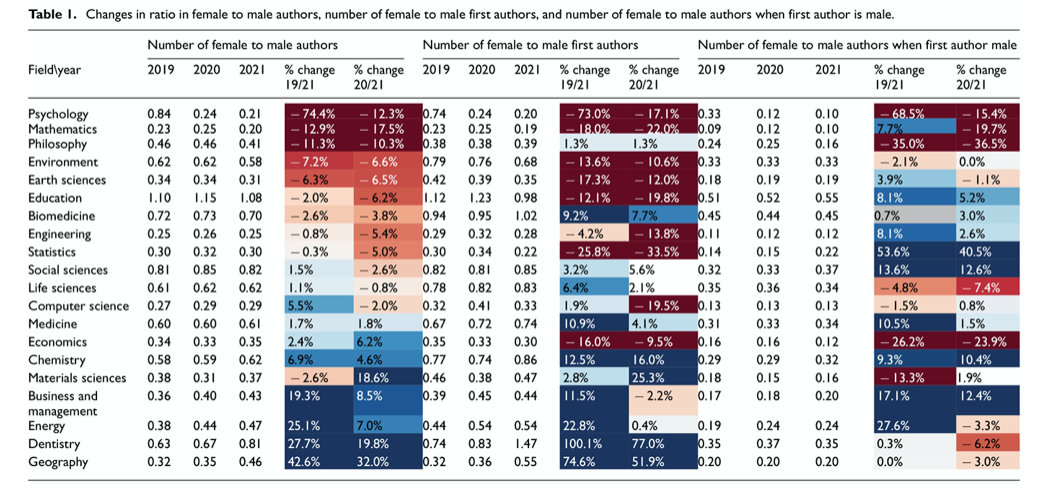You have /5 articles left.
Sign up for a free account or log in.

metamorworks/iStock/Getty Images Plus
A new study of COVID-19–era publication patterns by gender contradicts earlier research on the topic, suggesting that women haven’t published less than they did prior to the pandemic, over all.
What the study calls gender inequality has grown in some fields during this period of increased caregiving demands and quarantine, however—in psychology, math and philosophy, specifically.
“Our results do not offer a complete picture,” says the study, published in the Journal of Information Science. Yet the results “clearly indicate that COVID-19 bias in gender publication patterns is not clear[;] the picture is complicated, and calls for further studies.”
Seeking to verify other evidence that women’s research productivity has been disproportionately affected by COVID-19, researchers involved in the new study considered 266,409 articles published in 2019, 2020 and January 2021 in 2,813 journals, across 21 disciplines, assuming all the authors' genders by their first names. All the articles were from the Springer-Nature database.
The idea was to compare publication rates by gender in each of those three years, looking for major discrepancies between 2019, entirely before the pandemic, and after. Contrary to numerous other studies with different methodologies and different data sets showing that women have fallen behind men in terms of publishing since early 2020, this study found no significant differences between the three years.
That’s over all. There were significant differences in certain disciplines, however. The biggest decrease in proportion of women authors was in psychology (down 74.4 percent between 2019 and January 2021 and down 12.3 percent between 2020 and January 2021). The second-biggest drop was in math (down 12.9 percent and 17.5 percent, respectively), followed by philosophy (down 11.3 percent and 10.3 percent, respectively).
 The authors say it's “interesting” that philosophy and math would be so apparently affected by COVID-19, “as these disciplines do not typically require experimental studies with human subjects, and as such should be less prone to be affected by the pandemic.” Then again, much anecdotal evidence suggests that COVID-19–related research delays aren’t just about external hurdles but also about not having time left over after teaching, service and caregiving (if applicable) to write.
The authors say it's “interesting” that philosophy and math would be so apparently affected by COVID-19, “as these disciplines do not typically require experimental studies with human subjects, and as such should be less prone to be affected by the pandemic.” Then again, much anecdotal evidence suggests that COVID-19–related research delays aren’t just about external hurdles but also about not having time left over after teaching, service and caregiving (if applicable) to write.
The biggest increase in female to male author ratio in 2021, meanwhile, was in geography (42.6 percent increase from 2019 and 32 percent increase from 2020), followed by dentistry (27.7 percent and 19.8 percent, respectively), and energy (25 percent and 7 percent, respectively).
“The results for dentistry are especially interesting when the fact that medicine, in general, is a discipline with a faster publication turnaround,” relative to other fields, the study says.
In math and psychology, the new study also identified a drop in the number of articles with women as first authors during COVID-19, as well as the number of male first-author articles with women as co-authors.
“These drops may suggest that in these fields, a culture of gender bias is more widespread than in the others,” the study says.
Another significant finding: in disciplines where the share of women authors was higher, there were fewer single-authored articles.
First-author gender appeared to affect the women-to-men ratio among co-authors, the study also found. In multiauthor articles with women as first authors, there tended to be more of a gender balance among authors: the average ratio across years and fields was 0.68 when a woman was the first author and 0.40 when the first author was male.
Co-author Dariusz Jemielniak, professor of organization and management studies at Kozminski University in Poland and faculty associate at the Berkman Klein Center for Internet and Society at Harvard University, said that “there are a lot of misunderstandings about gender bias in academia.” And while he’s “convinced” that this bias does exist, Jemielniak said “relying on a stereotype of how it works is counterproductive. We need to make policies data-driven, and it is important to basically observe these data rather than assume that a perception is enough.”
Jemielniak said one practical policy implication “could be to be very careful with regard to tenure review process changes. My gut feeling—not research based—is that there likely was a significant bias, but it was granular. For instance, I would not be surprised at all if it turned out that while women scholars have not been as affected, mothers of young children were, very disproportionately, even to fathers of young children.”
Limitations and Cautions
Jemielniak also noted that these data need to continue to be collected, as outcomes may be delayed, given the relatively slow nature of academic publishing. The researchers assumed average turnaround times of about three to six months from paper submission to publication, which falls clearly within the scope of the time period studied. But Jemielniak said it’s “entirely possible that the actual publishing results from lockdowns will be delayed and observable as late as in 2023.” Moreover, he said, the study can’t account for papers that were rejected multiple times, delaying their eventual publication dates.
Kathleen Dolan, distinguished professor of political science at the University of Wisconsin at Milwaukee and co-editor of the American Journal of Political Science, found very early on in the pandemic—as part of a much broader look at gendered patterns in AJPS—that women were actually publishing slightly more than usual, but publishing fewer solo-authored papers.
Dolan said this week that she didn’t necessarily support the anecdotal idea that women have been affected more than men during COVID-19, but that this new study doesn’t get “at the question in the right way.”
Considering journal articles in 2019, 2020 and January 2021 isn’t “enough to time see an actual COVID-related pattern,” she said. “In many disciplines, an article that gets submitted at Time X and is ultimately accepted for publication may not see print for up to two years.” In political science, for instance, she continued, one full year from submission to publication would be considered “fast.”
If COVID-19 really has been hurting women academics more in terms of lost research time, “we shouldn’t expect to see that impact until the journals that are published in 2022 at the earlier, but more likely 2023 and 2024.”
In this light, Dolan said that Jemielniak’s article “would be a great baseline” for later comparisons.
For this reason, several other studies on the gendered effects of COVID-19 among academics have looked at submissions to preprint repositories, where scholars share papers long before they’re formally published. Cassidy Sugimoto, Tom and Marie Patton School Chair in the School of Public Policy at the Georgia Institute of Technology, co-wrote one such preprint study in May 2020, and said of Jemielniak’s paper, “I would also be cautious about these data representing the true extent of the data. We are still in a pandemic, and long publication delays distort the reality of what is currently happening in the lab.”






